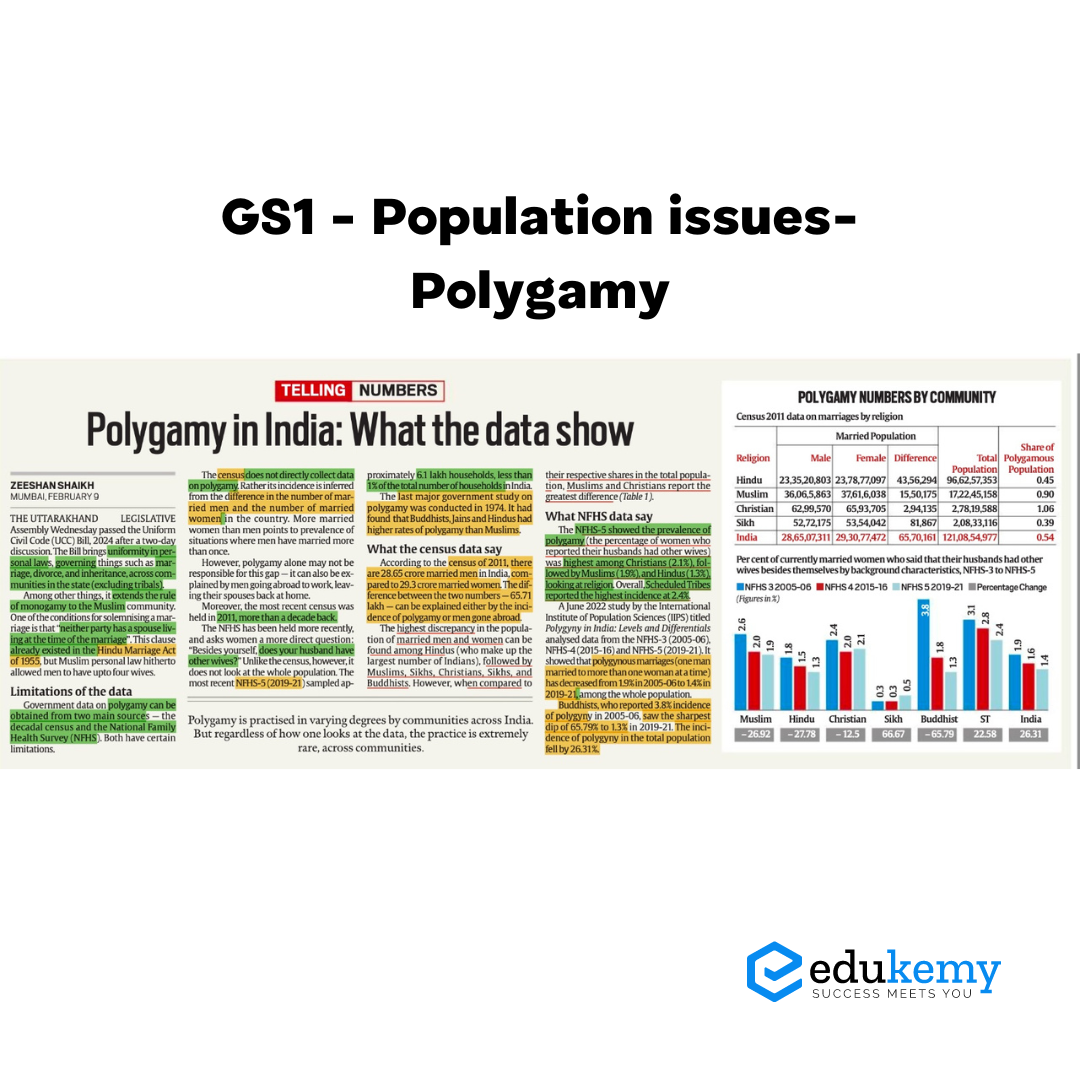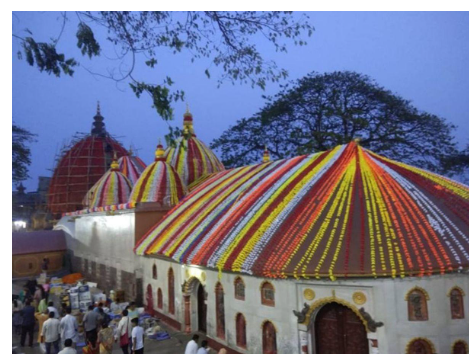Tuesday, 13th February 2024
Daily News Paper Snippets - 13th February 2024





Bills to Include PVTGs to ST List in Odisha and AP
In News: Two bills, aimed at modifying the lists of Scheduled Castes (SC) and Scheduled Tribes (ST) in Andhra Pradesh and Odisha, were recently passed by voice vote in the Lok Sabha.
Andhra Pradesh: The Constitution (Scheduled Tribes) Order (Amendment) Bill, 2024
- Background
- The Bill aims to amend the Constitution (Scheduled Tribes) Order, 1950, specifically in relation to Andhra Pradesh.
- Proposed Changes
- Addition of Particularly Vulnerable Tribal Groups (PVTGs) to the ST list in Andhra Pradesh:
- Bondo Porja
- Khond Porja
- Konda Savaras
- Addition of Particularly Vulnerable Tribal Groups (PVTGs) to the ST list in Andhra Pradesh:
- Importance
- Rectifying Disparities
- Addresses historical discrepancies in the treatment of tribes across different regions.
- Ensures equitable recognition and status for PVTGs like Bondo Porja, Khond Porja, and Konda Savaras.
- Equitable Access
- Ensures that communities facing discrimination in certain regions gain equal access to government provisions and services.
- Aims to create a level playing field for these tribes.
- Affirmative Action
- Provides PVTGs listed as STs with reservation quotas in education, employment, and political representation.
- Fosters inclusive development by addressing long-standing disparities.
- Rectifying Disparities
Odisha: The Constitution (Scheduled Castes and Scheduled Tribes) Orders (Amendment) Bill, 2024
- Background
- The Bill seeks to amend the Constitution (Scheduled Castes) Order, 1950, and the Constitution (Scheduled Tribes) Order, 1950, specifically impacting the SCs and STs in Odisha.
- Proposed Changes
- Addition of PVTGs to the ST list in Odisha:
- Pauri Bhuyan and Paudi Bhuyan (synonyms of Bhuyan Tribe)
- Chuktia Bhunjia (recognized as Bhunjia tribe)
- Bondo community (sub-tribe of Bondo Poraja)
- Mankidia community (synonym of Mankirdia tribe)
- Introduction of two new entries: Muka Dora and Konda Reddy tribes.
- Removal and Transition
- Tamadia and Tamudia communities move from the list of SCs to the list of STs in Odisha.
- Importance
- Addressing Discrimination:
- Recognizes tribes like Konda Reddy and Muka Dora as ST in Odisha, eliminating discriminatory practices.
- Aims to create a more inclusive and harmonized approach to tribal categorization.
- Equitable Opportunities
- Expanding the ST list ensures access to reservation quotas for education, employment, and political representation.
- Promotes social justice by correcting historical injustices and ensuring fair representation.
- Affirmative Action in Education
- ST status facilitates affirmative action in educational institutions, providing equal opportunities for PVTG students.
- Supports the development and empowerment of marginalized tribal communities in Odisha.
|
UPSC Previous Year Questions Prelims (2019) Q. Consider the following statements about Particularly Vulnerable Tribal Groups (PVTGs) in India:
Which of the statements given above are correct? (a) 1, 2 and 3 Ans: (c) Mains (2017) Q. What are the two major legal initiatives by the State since Independence addressing discrimination against Scheduled Tribes (STs)? Mains (2016) Q. Why are the tribals in India referred to as ‘the Scheduled Tribes’? Indicate the major provisions enshrined in the Constitution of India for their upliftment. |
Source: TH
Regulating Online Gaming in India
In News: The Ministry of Electronics and Information Technology (MeitY) is set to formulate a framework for the approval and certification of online games that entail monetary transactions.

Types of Online Gaming
- e-Sports
- Originally played privately or on consoles in the 1990s, e-Sports have evolved into structured online competitions among professional players, either individually or in teams.
- Fantasy Sports
- Involves selecting a team of real sports players from different teams, earning points based on their real-life performance. Example: Dream11.
- Online Casual Games
- Can be skill-based, where outcomes rely on mental or physical skills, or chance-based, influenced by random activities like rolling a die.
- Chance-based games may be considered gambling if monetary bets are involved.
The Online Gaming Market in India - Scale and Growth
- Industry Growth
- The Indian online gaming sector is a rapidly growing home-grown start-up ecosystem, expanding at a 27% compound annual growth rate (CAGR).
- Projections suggest that the synergy of AI and online gaming could contribute up to $300 billion to India’s GDP by 2026-27.
- Rising User Base
- India has witnessed the fastest growth in new paying users (NPUs) in the gaming world, reaching 40% in 2020 and anticipated to reach 50% in 2021.
- Transaction-based games revenue increased by 26% in 2021, with paying players rising from 80 million in 2020 to 95 million in 2021.
Challenges Faced by the Online Gaming Market in India
- Lack of Regulatory Oversight
- Absence of a regulatory framework for various aspects of online gaming companies, including grievance redressal, player protection, data and IP rights, and prohibition of misleading advertisements.
- Difficulty for individuals to distinguish between legitimate gaming platforms and illegal gambling sites.
- Safety and Financial Implications
- Growth of illegal offshore gambling markets poses risks of money laundering and national security concerns.
- Estimated annual loss of $45 billion in taxation due to the operations of illegal offshore markets.
- Online Gaming as a State Subject
- Some State governments attempt to ban online gaming, but cross-border nature of the Internet makes enforcement challenging.
- Societal Concerns
- The rapid ascent of online gaming raises concerns about addiction, mental health, suicides, financial frauds, privacy, and data security.
The Issue of Self-Regulatory Bodies under the IT Rules
- Regulatory Landscape
- IT (Intermediary Guidelines and Digital Media Ethics Code) Rules 2021 require approval from a regulatory body for online real money games.
- Industry Response
- Industry given three months to propose self-regulatory bodies (SROs) under the online gaming rules.
- Concerns arise as proposals are dominated by gaming companies and industry associations, potentially lacking neutrality.
Source: IE
Pradhan Mantri Matsya Kisan Samridhi Sah-Yojana and FIDF
In News: The Union Cabinet recently granted approval to the "Pradhan Mantri Matsya Kisan Samridhi Sah-Yojana (PM-MKSSY)," and it has also extended the Fisheries Infrastructure Development Fund (FIDF) for an additional three years until 2025-26.
Pradhan Mantri Matsya Kisan Samridhi Sah-Yojana (PM-MKSSY)
Overview
- PM-MKSSY, a Central Sector Sub-scheme within the Pradhan Mantri Matsya Sampada (PMMSY), focuses on the formalization of the fisheries sector.
- With an investment exceeding Rs. 6,000 crores over the next four years (FY 2023-24 to FY 2026-27), it aims to support fisheries micro and small enterprises across all States/Union Territories.
Objectives
- Gradual Formalisation of the Unorganised Fisheries Sector
- Self-registration of fishers, fish farmers, and supportive workers through the National Fisheries Sector Digital Platform (NFDP).
- Facilitate access to institutional financing for micro and small enterprises in the fisheries sector.
- Incentivizing Adoption and Expansion
- Provide a one-time incentive for beneficiaries to purchase aquaculture insurance.
- Encourage the adoption and expansion of safety and quality assurance systems for fish and fishery products, ensuring job maintenance.
Intended Beneficiaries
- Fishers, Fish (Aquaculture) Farmers, fish workers, vendors, and stakeholders in the fisheries value chain.
- Micro and Small enterprises, including proprietary firms, partnership firms, cooperatives, federations, startups, Fish FPOs (FFPOs), and more engaged in fisheries and aquaculture.
- Other beneficiaries as identified by the Department of Fisheries.
Implementation Strategy
- Formalisation of Fisheries Sector (Component 1-A)
- Establishment of NFDP for creating a national registry of stakeholders.
- NFDP functions include training, financial literacy improvement, project preparation assistance, and strengthening fisheries cooperative societies.
- Facilitating Adoption of Aquaculture Insurance (Component 1-B)
- Creation of insurance products for aquaculture, covering a specified area.
- Incentives provided based on farm size, with additional benefits for SCs, STs, and Women beneficiaries.
- Supporting Microenterprises (Component 2)
- Improving value chain efficiencies through performance grants.
- Grant percentages vary based on ownership (General Category, SC/ST/Women-owned, Village Level Organizations, and Federations).
- Fish and Fishery Product Safety (Component 3)
- Incentivize enterprises for safety and quality, contributing to market expansion and job creation.
- Grants determined based on enterprise size and ownership.
- Project Management, Monitoring, and Reporting (Component 4)
- Establishment of Project Management Units (PMUs) for effective project management, implementation, monitoring, and evaluation.
Fisheries Infrastructure Development Fund (FIDF)
Overview
- Established by the Department of Fisheries under the Ministry of Fisheries, Animal Husbandry & Dairying.
- FIDF complements schemes such as PMMSY (Pradhan Mantri Matsya Sampada Yojana) and KCC (Kisan Credit Card).
Objectives
- Envisages the creation of fisheries infrastructure facilities in both marine and inland fisheries sectors.
Implementation Mechanism
- Concessional Finance
- FIDF provides concessional finance to Eligible Entities (EEs) through Nodal Loaning Entities (NLEs).
- NLEs include NABARD, National Cooperatives Development Corporation (NCDC), and all scheduled Banks.
- Eligible Entities (EEs) under FIDF
- State governments
- Cooperatives
- Fisheries cooperative federations
- NGOs
- Women entrepreneurs
- Private companies, and more.
- Interest Subvention
- The Indian Government offers an interest subvention of up to 3% per annum.
- Repayment period spans 12 years, including a 2-year moratorium, with NLEs providing concessional finance at a minimum interest rate of 5% per annum.
|
UPSC Previous Year Questions Prelims (2014) Q. Other than poaching, what are the possible reasons for the decline in the population of Ganges River Dolphins?
Select the correct answer using the code given below: (a) 1 and 2 only Ans: (c) Prelims (2020) Q. Under the Kisan Credit Card scheme, short-term credit support is given to farmers for which of the following purposes?
Select the correct answer using the code given below: (a) 1, 2 and 5 only Ans: (b) Mains (2018) Q. Defining blue revolution, explain the problems and strategies for pisciculture development in India. |
Source: PIB
Atmospheric River
In News: California in the United States is currently facing an unprecedented weather event referred to as an Atmospheric River, commonly known as the Pineapple Express Storm. This phenomenon has the capacity to release as much as 8 trillion gallons of rain across the state.

Atmospheric River: A Moisture Transport Phenomenon
- Overview
- An atmospheric river is a lengthy and narrow band of moisture-laden air, transporting substantial water vapor from the tropics to higher latitudes.
- Often associated with mT (Maritime Tropical) air mass, these rivers release intense precipitation upon making landfall, leading to either rain or snow depending on altitude and temperature.
Pineapple Express: A Notable Atmospheric River
- The "Pineapple Express" exemplifies atmospheric river storms affecting the US West Coast, particularly California.
- Draws moisture from tropical waters near Hawaii, resembling an express train of moisture linked with pineapples.
- Driven by a robust southern branch of the polar jet stream, it transports humid, warm mT air from as far as the Hawaiian Islands.
Categories of Atmospheric Rivers: Assessing Impact
- Category 1 (Weak)
- Milder and shorter weather events with primarily beneficial effects, such as 24 hours of modest rainfall.
- Category 2 (Moderate)
- Moderate storms with a mix of beneficial and hazardous effects.
- Category 3 (Strong)
- More powerful and longer-lasting, bringing both beneficial and hazardous impacts.
- Category 4 (Extreme)
- Primarily hazardous, with the potential for heavy rain over several days leading to floods.
- Category 5 (Exceptional)
- Predominantly hazardous in nature.
Significance of Atmospheric Rivers: Water Supply and Management
- Crucial role in replenishing water supplies, particularly in regions like the western United States.
- Significant contribution to reservoir levels, aiding in alleviating drought conditions and ensuring water availability for various purposes.
Global Occurrence of Atmospheric Rivers: Beyond the US West Coast
- Not confined to the US West Coast; they occur worldwide, affecting regions such as the UK, Ireland, Norway, and China.
- Impact the rainy season in China, known as Mei-Yu season.
Frequency and Predictability: A Key Aspect
- While comprising only 17% of storms on the US West Coast, atmospheric rivers significantly contribute to California's precipitation, snowpack, and major floods.
- Predictable and forecastable up to a week in advance, allowing for effective preparation and management.
|
UPSC Previous Year Questions Prelims (2011) Q. The formation of ozone hole in the Antarctic region has been a cause of concern. What could be the reason for the formation of this hole? (a) Presence of prominent tropospheric turbulence; and inflow of chlorofluorocarbons (b) Presence of prominent polar front and stratospheric clouds; and inflow of chlorofluorocarbons (c) Absence of polar front and stratospheric clouds; and inflow of methane and chlorofluorocarbons (d) Increased temperature at polar region due to global warming Ans: (b) Mains (2021) Q.1 How do the melting of the Arctic ice and glaciers of the Antarctic differently affect the weather patterns and human activities on the Earth? Explain. Mains (2018) Q.2 Why is India taking keen interest in resources of Arctic region? Mains (2017) Q.3 How does the cryosphere affect global climate? |
Source: TOI
Nazool Land
In News: Uttarakhand recently witnessed outbreaks of violence following the demolition of a mosque and a madrasa situated on Nazool land.

Nazool Land: Overview and Governance
- Ownership and Administration
- Nazool land is government-owned but not directly administered as state property.
- Typically, the state allocates such land on lease for fixed periods, ranging from 15 to 99 years.
- Lease Renewal Process
- Leaseholders can approach the authority for renewal by submitting a written application to the Revenue Department of the local development authority.
- The government has the discretion to either renew or cancel the lease, reclaiming Nazool land.
- Allotment Across India
- Nazool land is allocated to various entities for diverse purposes in major cities across India.
- Historical Origin
- Emerged during British rule, post-battles with opposing kings who lost their lands.
- British took possession, and after Independence, these lands became Nazool land, owned by state governments.
- Usage by the Government
- Governments utilize Nazool land for public infrastructure like schools, hospitals, Gram Panchayat buildings, etc.
- In several cities, Nazool land is leased for housing societies.
- Legal Framework
- The Nazool Lands (Transfer) Rules, 1956, primarily govern Nazool land adjudication.
- While various states may issue government orders, this law is commonly used for regulatory purposes.
Source: IS
#BBD0E0 »
Alaskapox
In News: An elderly individual from Alaska recently became the initial fatality resulting from contracting Alaskapox.

Alaskapox: Overview
- Discovery and Location
- Alaskapox is an orthopox virus first identified in Alaska, USA, in 2015.
- Virus Classification
- It belongs to the Orthopoxvirus genus, the same genus as smallpox, monkeypox, and cowpox.
- Orthopoxviruses are zoonotic, capable of infecting various mammals, including humans.
- Target Hosts
- Current evidence suggests that Alaskapox primarily affects small mammals.
- Most commonly identified in red-backed voles and shrews.
- Signs and Symptoms
- Clinical manifestations include skin lesions (bumps or pustules), swollen lymph nodes, and joint/muscle pain.
- Patients generally experience mild illnesses that self-resolve within a few weeks.
- Immunocompromised individuals may face a higher risk of severe illness.
- Transmission Risk
- While human-to-human transmission of Alaskapox has not been observed, certain orthopoxviruses can spread through direct contact with lesions, especially broken skin contact with lesion secretions.
Source: TN
Unified Payment Interface (UPI) services in Sri Lanka and Mauritius
In News: The rollout of India's Unified Payment Interface (UPI) services in Sri Lanka and Mauritius will take place through a virtual ceremony.
Unified Payments Interface (UPI): Overview
- Development and Regulation
- UPI is a real-time digital payment system developed by the National Payments Corporation of India (NPCI) and regulated by the Reserve Bank of India (RBI).
- Launch Date
- It was officially launched on April 11, 2016.
- Core Functionality
- UPI facilitates peer-to-peer inter-bank transfers through a streamlined two-click factor authentication process.
- Distinct Features
- Simplifies transfers using recipient's UPI ID, whether it's a mobile number, QR code, or Virtual Payment Address, eliminating the need for account numbers.
- Removes the requirement to enter bank details or sensitive information with each transaction.
- Offers a consistent UPI transaction PIN across apps, enhancing cross-operability for 24/7 transactions.
- Digital Public Infrastructure
- Operates as a digital public infrastructure, allowing seamless interactions between merchants and customers without transaction costs.
- Payment Technologies
- Utilizes technologies like Immediate Payment Service (IMPS) and Aadhaar-Enabled Payment System (AEPS) to ensure smooth payments between accounts.
- Transaction Capabilities
- Facilitates push (pay) and pull (receive) transactions, supporting over-the-counter, barcode, and recurring payments such as utility bills and subscriptions.
- Enables "Peer-to-Peer" requests, which can be scheduled and paid based on need and convenience.
National Payments Corporation of India (NPCI): Overview
- Establishment and Objective
- NPCI is an umbrella organization for retail payments and settlement systems in India.
- It is an initiative of RBI and the Indian Banks’ Association (IBA) under the Payment and Settlement Systems Act, 2007.
- Promoter Banks
- Ten main promoter banks include Punjab National Bank, State Bank of India, Canara Bank, Union Bank of India, Bank of Baroda, ICICI Bank Limited, Bank of India, HSBC, Citibank, and HDFC Bank Limited.
- Corporate Structure
- Incorporated as a Not-for-Profit Company with the goal to provide infrastructure for both physical and electronic payment and settlement systems.
- Mission and Focus
- Focuses on bringing innovations to retail payment systems through technology, enhancing efficiency, and expanding the reach of payments.
- Regulatory Board
- Headquartered in Mumbai, the regulatory board includes nominees from RBI and ten core promoter banks, ensuring collaborative governance.
Source: IE
Kawal Tiger Reserve - Edukemy Current Affairs
In News: Recently, authorities responsible for forest management in the Kawal Tiger Reserve have taken action by suspending six staff members due to their negligence in controlling teak smuggling.
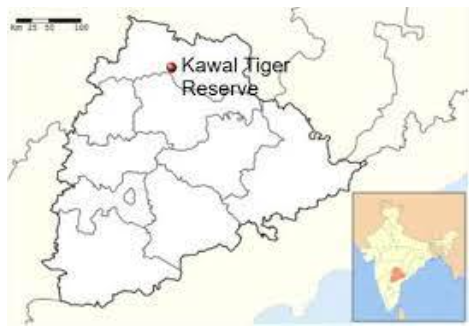
Kawal Tiger Reserve: Overview
- Location
- Situated in the north-eastern part of Telangana (Old Adilabad district), bordered by the Godavari River on one side and Maharashtra on the other.
- Forms part of the Deccan peninsula-central highlands.
- Tiger Reserve Declaration
- Designated as a Tiger Reserve by the Government of India in 2012.
- Rivers and Catchment
- The reserve serves as the catchment for the Godavari and Kadam rivers, both flowing southward within the sanctuary.
- Geographical Placement
- Positioned at the southernmost tip of the Central Indian Tiger Landscape, with linkages to Tadoba-Andhari (Maharashtra) and Indravati (Chhattisgarh) tiger reserves.
- Habitat Diversity
- Encompasses diverse habitats, including dense forests, grasslands, open areas, rivers, streams, and water bodies.
- Vegetation Type
- Characterized as Southern Tropical Dry Deciduous Forest.
- Flora
- Abundant presence of Teak and Bamboo.
- Records indicate 673 plant species, featuring Anogeissus latifolia, Mitragyna parviflora, Terminalia crenulata, Terminalia arjuna, Boswellia serrata, among others.
- Fauna Diversity
- Faunal diversity representative of the Deccan Plateau.
- Major wildlife includes nilgai, chousinga, chinkara, black buck, sambar, spotted deer, wild dog, wolf, jackal, fox, tiger, leopard, and jungle cat.
Source: DC
Bochasanwasi Akshar Purushottam Swaminarayan Sanstha (BAPS)
In News: The Prime Minister is set to inaugurate the BAPS Mandir, the initial Hindu temple in Abu Dhabi, affiliated with Bochasanwasi Akshar Purushottam Swaminarayan Sanstha (BAPS).
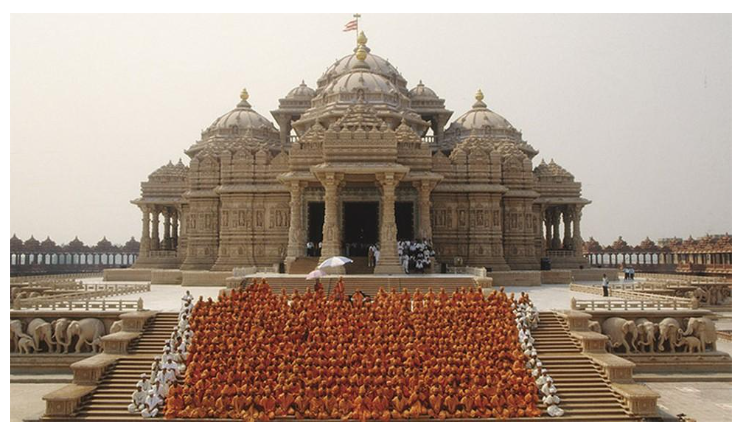
Bochasanwasi Akshar Purushottam Swaminarayan Sanstha (BAPS): Overview
- Origin and Foundation
- Rooted in the Vedas, BAPS is a socio-spiritual Hindu faith.
- Based on Vedic teachings propagated by Bhagwan Swaminarayan (1781-1830 CE).
- Formally established in 1907 CE by Brahmaswarup Shastriji Maharaj.
- Core Principles
- Founded on practical spirituality.
- Addresses spiritual, moral, and social challenges.
- Lifetime Vows
- Followers adhere to five lifetime vows: No Alcohol, No Addictions, No Adultery, No Meat, No Impurity of body and mind.
- Global Network
- Mandirs and centers worldwide.
- Hosts moral, social, cultural, and spiritual activities.
- Education and Women Development
- Focus on education and women's development.
- Manages schools, hostels, and community development activities targeting women.
- Humanitarian Activities
- Engaged in various humanitarian endeavors:
- Services during natural calamities.
- Operation of primary schools, students’ hostels, and hospitals.
- Diagnostic camps and anti-addiction drives.
- Environment-awareness programs, tribal uplift, and literacy campaigns.
- International Recognition
- Holds NGO status with Consultative Status in the Economic and Social Council of the United Nations.
Source: DD News
SWATI Portal
In News: The launch of the "Science for Women-A Technology & Innovation (SWATI)" Portal was initiated by the Principal Scientific Advisor to the Government of India.
About The SWATI Portal
- The SWATI Portal aims to establish a unified online platform representing Indian Women and Girls in STEMM (Science, Technology, Engineering, Mathematics & Medicine).
- Developed, hosted, and maintained by the National Institute of Plant Genome Research (NIPGR) in New Delhi, it serves as a comprehensive interactive database.
- The primary objective is to contribute to policy-making by addressing gender-gap challenges in STEMM fields.
- The portal is the first of its kind in India, facilitating reliable and statistically significant long-term research on issues related to equality, diversity, and inclusivity.
- It endeavors to include every Indian woman in science across all career stages and subjects, encompassing both academia and industry.
- Sections within the portal cover various categories such as Icons (Awardees of Padma, Shanti Swarup Bhatnagar, and Stree Shakti Science Samman), Directors, Secretaries Academy Presidents, and Faculty from Indian Universities, Autonomous organizations, and S&T Ministries.
- The searchable database includes information such as Name, Affiliation, and Area of Interest, providing a comprehensive overview of women in STEMM in India.
Source: PIB
Why India Needs a Forward-Looking Approach to Bilateral Investment Treaties
In News: India's economic scenario is undergoing a significant shift, marked by a crucial announcement from the Finance Minister outlining a strategic initiative to engage in negotiations for Bilateral Investment Treaties.
Evolution of Bilateral Investment Treaties (BITs) in India
- Genesis of BITs in India (1990s)
- In the mid-'90s, India initiated BITs to foster a favorable environment for Foreign Direct Investment (FDI).
- Objective: Signal commitment to protect investments of individuals and companies from partner nations.
- First BIT signed between India and the UK in 1994, laying the foundation for global economic integration.
- Proliferation of BITs as Economic Diplomacy (Late 90s to 2000s)
- BITs evolved into strategic instruments reciprocally promoting and safeguarding investments.
- Crucial in positioning India as a global investment destination.
- Surge in the number of BITs reflected India's recognition of the role of foreign capital.
- Challenges and Disputes (2010s)
- 2010 marked the settlement of the first-ever investor treaty claim in India.
- Adverse award in the Australia-India BIT dispute highlighted complexities.
- By 2015, India faced 17 known BIT claims, including the prominent Cairn Energy Plc case.
- Adoption of the 2016 Model BIT and Policy Shift
- Significant shift in India's approach towards a protective model.
- Termination of existing treaties to recalibrate terms with foreign investors.
- Criticisms: Absence of key international law doctrines, requirement for exhausting local remedies.
Problems Associated with 2016 Model of BIT and Implications
- Protective Nature
- Shift raised concerns about India's attractiveness as an investment destination.
- Intent to protect rights but potential impact on overall investment climate questioned.
- Absence of Key International Law Doctrines
- Criticism for departing from established international law principles.
- Questions raised about fairness and protection afforded to foreign investors.
- Requirement for Exhausting Local Remedies
- Intended to encourage domestic dispute resolution.
- Challenges: Delays, uncertainties, potential discouragement for foreign investors.
- Adverse Impact on FDI and Renegotiation Challenges
- Decline in FDI evident, with challenges in renegotiating terms.
- Cairn Energy Plc case emblematic of challenges under the 2016 model BIT.
Recommendations, Policy Reforms Outlined by the Government Post Challenges Faced by 2016 BIT Model
- Recognition of Limitations and Policy Shift
- Acknowledgment of limitations prompts a shift towards flexible approaches.
- Emphasis on negotiating Bilateral Investment Treaties tailored to trade partners.
- Parliamentary Standing Committee Recommendations (2021)
- Critical recommendations to revisit the existing BIT regime.
- Emphasis on timely dispute settlement through pre-arbitration consultations.
- Recommendations to Address India's Ranking in Ease of Contract Enforcement
- India's low ranking prompts a call to enhance the ease of doing business.
- Timely treaty review aligned with global best practices is imperative.
- Free Trade Agreement (FTA) with the UK
- Ongoing efforts to conclude an FTA with the UK.
- Negotiations include addressing disputes without exhausting local remedies for timely resolution.
Conclusion
- A progressive approach to BITs crucial for a $5-trillion economy.
- Emphasis on attracting sustained foreign investments through nuanced and adaptable strategies.
- Need to pave the way for rapid yet sustainable growth in cross-border flows.
Source: IE
"Pregnant Tribal Women Hostels" - Case Study of the Day
In remote villages of Vizianagaram with inadequate road connectivity, pregnant women faced risks using dollies for transportation, leading to high maternal mortality rates.
- To address this, the District Administration and Integrated Tribal Development Agency initiated the construction of hostels for pregnant women from these areas.
- Frontline workers, including ASHAs and Anganwadi staff, raise awareness about these hostels, where pregnant women stay a month before the Expected Delivery Date (EDD).
- The hostels offer home-like care, nutritional support, and intensive medical attention under gynecologists' supervision.
- Dedicated ambulances transport women to and from the hostels, ensuring safe deliveries and postnatal care.
- Approximately 100 women from hill-top villages have benefited from these hostels, receiving positive responses from the tribal communities.
- The mothers express satisfaction with the facilities provided.

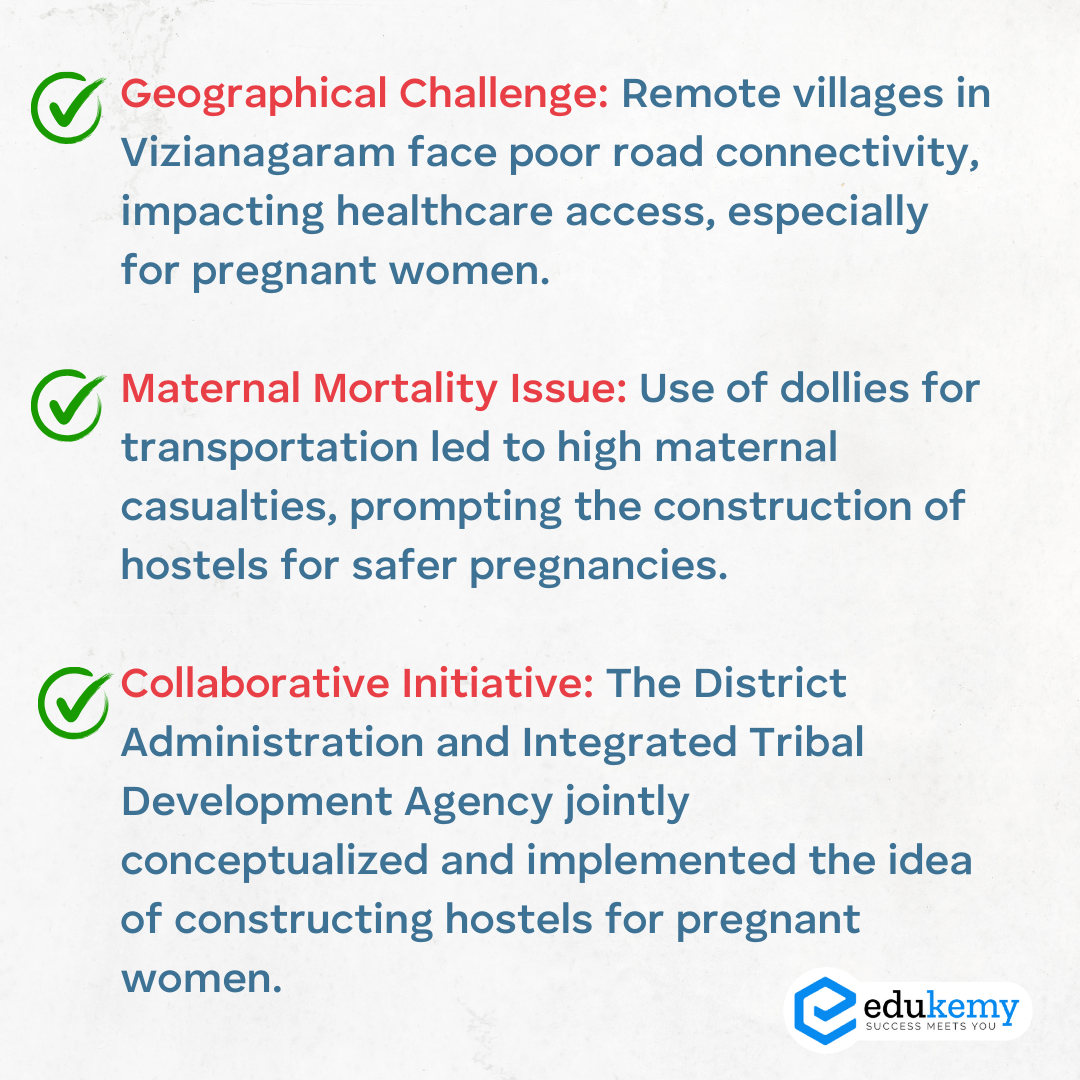

Share the article
Edukemy’s Current Affairs Quiz is published with multiple choice questions for UPSC exams
MCQ
Get Latest Updates on Offers, Event dates, and free Mentorship sessions.

Get in touch with our Expert Academic Counsellors 👋
FAQs
UPSC Daily Current Affairs focuses on learning current events on a daily basis. An aspirant needs to study regular and updated information about current events, news, and relevant topics that are important for UPSC aspirants. It covers national and international affairs, government policies, socio-economic issues, science and technology advancements, and more.
UPSC Daily Current Affairs provides aspirants with a concise and comprehensive overview of the latest happenings and developments across various fields. It helps aspirants stay updated with current affairs and provides them with valuable insights and analysis, which are essential for answering questions in the UPSC examinations. It enhances their knowledge, analytical skills, and ability to connect current affairs with the UPSC syllabus.
UPSC Daily Current Affairs covers a wide range of topics, including politics, economics, science and technology, environment, social issues, governance, international relations, and more. It offers news summaries, in-depth analyses, editorials, opinion pieces, and relevant study materials. It also provides practice questions and quizzes to help aspirants test their understanding of current affairs.
Edukemy's UPSC Daily Current Affairs can be accessed through:
- UPSC Daily Current Affairs can be accessed through Current Affairs tab at the top of the Main Page of Edukemy.
- Edukemy Mobile app: The Daily Current Affairs can also be access through Edukemy Mobile App.
- Social media: Follow Edukemy’s official social media accounts or pages that provide UPSC Daily Current Affairs updates, including Facebook, Twitter, or Telegram channels.


